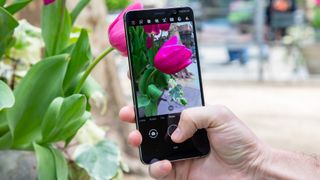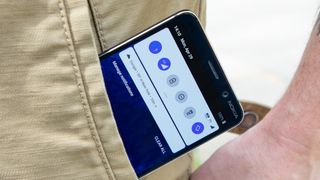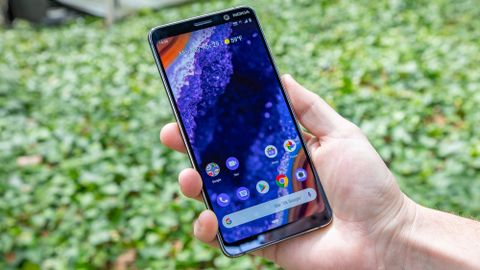Why you can trust TechRadar

Camera
With no further ado – the cameras.
Yes, this is the make-or-break reason to buy a Nokia 9 PureView. If you want the short verdict: no, the phone’s unique five-lens setup does not vastly outpace the cameras on top-tier flagships. But it does outperform mid-range phones, and given the ability to export its photos in the RAW-derived DNG format, allows the pro shooter to tinker with shots in post-production.
But for casual photographer, the phone is a good, though not dominant, choice.
A bit of context: only two of the phone’s five rear 12MP f/1.8 cameras are in color (the center-center and center-lower one), while the three in the top, bottom-right and bottom-left are all monochrome lenses positioned just so to combine photos taken simultaneously with every lens. This is intended to capture greater ranges of color and depth, which it does, to varying degrees.

Nokia 9 PureView
Here's the Nokia 9 PureView in a basic shot, no editing.

Google Pixel 3 XL
Here's a shot with one of our camera phone favorites, the Google Pixel 3 XL. Note the brighter, warmer look and even color spread along with clarity.

Huawei P30 Pro
Here's one with the Huawei P30 Pro, our current favorite camera phone. Clear foreground, but with obvious blowouts where the top-lighting is brightest.

Samsung Galaxy S10 Plus
This one is shot with the Samsung Galaxy S10 Plus at a less-than-opportune moment (sorry Matt!). Note the clarity in the background text and definition in the shirt, but the less-clear (smoothed-over) skin.

OnePlus 6T
The OnePlus 6T is one of our sub-flagship favorites, and does a pretty good job here, though it doesn't get quite as much texture from the shirt and forearms as other phones.
In practice, and without editing, the Nokia 9’s photos tend to look darker and less vibrant than those taken with other phones. They have more detail in the shadows – think stubble under a bearded jaw or the underside of a bridge – but streaks of bright light can lead to blown out patches. Daytime shots often have a color range more reflective of reality (i.e. less vivid) than other phones, but their lighting can vary from shot to shot, making it a good (if frustrating) idea to take multiple pictures.
What’s wild, and a bit annoying, is that you won’t see this mutedness unless you closely compare shots between phones...on a separate monitor. The Nokia 9’s more-vibrant-by-default display can make photos look brighter than they end up being.

Nokia 9 PureView
This is where the Nokia 9 PureView shines. While the front subject isn't terribly well-lit, take note of the background building (across the street) as well as the detail in the archway above. But also note the "gauzy" quality of this shot in comparison to others.
Also note the blurs in this and successive photos, indicating processing time. Some are worse than others.

Huawei P30 Pro
The Huawei P30 Pro is our favorite camera phone, but note again the low-lit foreground figure. The background building is lit and clear, as is the archway.

Google Pixel 3 XL
Here's the Google Pixel 3 XL, one of our favorite cameras for its all-rounded quality. Decent foreground though a lack of color contrast (the shirt is bluer in other phone photos), but good background and archway detail. Note how most figures are in focus.

Samsung Galaxy S10 Plus
The Samsung Galaxy S10 Plus is another of our favorite camera phones -- here we see good background detail in the building and archway, but the foreground figure loses clarity and color contrast.

OnePlus 6T
The OnePlus 6T has been on our top lists for its value and all-around quality. Here it shows decent clarity and color in the foreground figure, and good archway detail, though the background building is a bit washed out. Still a good showing.
Predictably, the phone’s camera does well with shots in interstitial areas: if you’re in a tunnel mouth, say, it will do a respectable job capturing the interior foreground and exterior background, outcompeting some flagships. Unfortunately, we found these images to have a gauzy quality, lacking sharp focus as the lenses adapt to the differing light levels.

Nokia 9 PureView
The Nokia 9 PureView might take the best monochrome photos, but perhaps not off the bat - they're noticeably darker, requiring tweaking. But note the contrast quality in the pant legs, jacket, and desk's woodgrain compared to the following photos.

Huawei P30 Pro
The Huawei P30 Pro is our favorite camera phone at the moment, but this is still a B&W filter, not taken with a monochrome lens (which the P20 Pro had). But this shot is a bit easier on the eyes than the unedited Nokia 9 shot before.

Huawei Mate 20 Pro
The Huawei Mate 20 Pro has a less-powerful camera setup than the P30 Pro, but it represents a more all-around shooting system found on most flagships.
The phone also seems to outclass flagships in black-and-white shots, putting its monochrome lenses to work capturing more shadow detail than competing flagships’ B&W filters. Just expect, yes, these images to be dark and require a bit of tweaking to make figures visible.

The front-facing 20MP camera falls into the opposite problem: sharpness, but poor ability to handle multi-level lighting. Bright backgrounds are easily blown out.
David is now a mobile reporter at Cnet. Formerly Mobile Editor, US for TechRadar, he covered phones, tablets, and wearables. He still thinks the iPhone 4 is the best-looking smartphone ever made. He's most interested in technology, gaming and culture – and where they overlap and change our lives. His current beat explores how our on-the-go existence is affected by new gadgets, carrier coverage expansions, and corporate strategy shifts.

